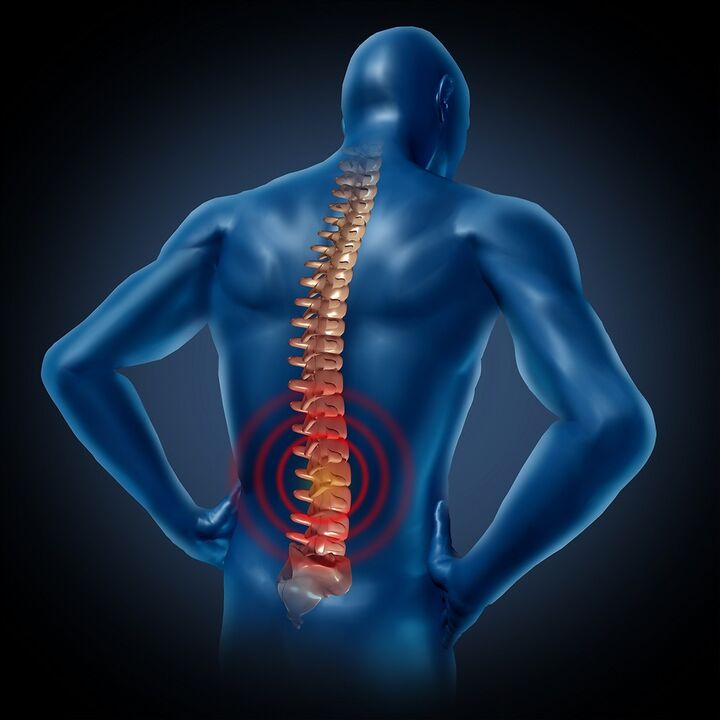Back pain is slightly less common than headaches. Every adult has experienced this feeling at least once. Usually, the neck and lower back are affected. Doctors think this is the reason why people's physical activity is declining, because many people both work and relax at the computer. This is the cause leading to the appearance of chronic degenerative diseases of the musculoskeletal system, the most common cause of which is back pain. Timely examination and treatment, regular physical activity and normalization of body weight will help to get rid of discomfort and regain the joy of movement.

general information
The high prevalence of low back pain is related to its anatomy. The base is the spine. Cartilaginous discs are located between the vertebrae, performing the function of absorbing shocks. The additional skeleton is provided by muscles and ligaments. The spinal cord enters the spinal column, from which the paired roots extend, feeding most organs and tissues.
A pathological process in any structure of the back, as well as internal organs connected to it by nerve fibers, can cause pain. Usually, a doctor needs to conduct a thorough diagnosis to find its source.
The reasons
Most conditions that cause pain in some part of the back are chronic. They start gradually and are symptom-free for a long time.
Among the external and internal causes that can trigger an exacerbation, the most common are:
- increased load on the spine against the background of frequent or overweight weight lifting;
- metabolic disorder;
- postural disorders and diseases of the musculoskeletal system (for example, arthritis of the hip or flat feet), which lead to unevenly distributed loads;
- Hypothermia;
- inflammatory and autoimmune processes;
- volume formation (tumor, abscess);
- pathology of the internal organs of the chest or abdominal cavity.
Diseases
Back pain can be a symptom of many diseases that can be divided into several groups.
Diseases of the spine or joints
This is the most common cause of back pain. Most diseases are associated with high and/or uneven loads on the spine:
- osteonecrosis: the cartilage discs between the vertebrae begin to collapse, thin and be replaced by bone tissue; as a result, impaired function of the spine is affected, and the spinal cord or its roots are often compressed;
- disc herniation: the central part of the disc protrudes toward the spinal cord, compressing; the problem often arises against the background of advanced osteonecrosis;
- ankylosing spondylitis: autoimmune inflammation of the joints and ligaments of the spine, leading to painful spasms of the surrounding muscles; over time, it becomes the cause of fused vertebrae;
- spondylolisthesis: displacement of the vertebrae from its normal position, which can lead to compression of the roots or spinal cord;
- rheumatoid arthritis: arthritis of an autoimmune nature; more often affects the cervical spine;
- osteomyelitis: inflammation of bone tissue.
Muscle tissue disease
Muscle tissue is often involved in the pathological process in the pathology of bone or joint tissue. In this case, painful spasms appear in the affected area. In addition, pain can occur against the background of:
- fibromyalgia: chronic pain in muscles and ligaments, often accompanied by stiffness and stiffness;
- myositis: an inflammatory process in the muscles that occurs against the background of hypothermia, stretching, trauma or physical overload;
- dermatomyositis: chronic lesions of the skin, muscles and internal organs, most likely of an autoimmune nature.
Diseases of the spinal cord and roots
Usually, the pain occurs due to compression of certain areas of nerve tissue due to trauma, tumor, bone necrosis, or herniated disc. An isolated lesion may be provoked by:
- inflammation associated with infections, including HIV and syphilis;
- multiple sclerosis;
- haemorrhage;
- lack of oxygen;
- vitamin or mineral deficiency.
Visceral disease
The nourishment of most internal organs is carried out by the roots of the spinal cord. As a result, any pathological process in them can become the cause of back pain. Usually, doctors face the following problems:
- kidney disease: pyelonephritis, urolithiasis;
- inflammation of the pelvic organs: salpingitis, salpingitis, prostatitis;
- pathology of the gallbladder: cholecystitis, gallstones;
- damage to the cardiovascular system: angina, heart attack, dissection of aortic aneurysm, pulmonary embolism;
- respiratory system diseases: pleurisy, pneumonia, abscess, pneumothorax;
- appendicitis.
Nature and location of pain
Localization and the nature of sensations can tell a lot about their origins. It's important to tell your doctor in as much detail as possible exactly what your back pain is like, so that your doctor can determine the cause and treat it as soon as possible.
Depending on its nature, the pain can be:
- acute: often occurs against the background of osteonecrosis, disc herniation, low back pain or myositis, often aggravated with movement;
- soreness: characteristic of chronic inflammatory processes in muscles, ligaments or internal organs;
- press or rupture: often refers to acute or chronic pathology of internal organs;
- Vibration, strong: often associated with trauma, low back pain, spondylolisthesis, exacerbation of osteonecrosis.
Locating the pain syndrome can also help diagnose:
- right side: liver disease, gallbladder, duodenum, right ovary or kidney damage, appendicitis;
- left: pathology of the spleen, left kidney or ovary, myocardial infarction, pancreatitis;
- in the lumbar region: sciatica, osteosarcoma, low back pain, Reiter's syndrome, herniated disc;
- below the waist: bone tumor or disc herniation, bilateral ovary inflammation, uterine pathology, menstrual cramps;
- right subclavian: liver disease, gallbladder, pancreas, right intercostal neuralgia, pleurisy, pneumonia;
- below the left shoulder blade: heart disease, left pneumonia, pleurisy, intercostal neuralgia, etc. v.
When you need to see a doctor urgently
Back pain can be both a sign of a relatively innocuous condition, and evidence of a dangerous process that requires immediate medical attention. A person urgently needs to consult a specialist in the following cases:
- pain that occurs after trauma;
- unable to find the location where the pain becomes weaker;
- there is an increase in temperature;
- signs of nerve damage: numbness, tingling, muscle weakness;
- pain that is worse at night;
- sensations accompanied by weakness, dark circles in the eyes, palpitations, cold sweats;
- pain relievers do not help with pain;
- disease still progressing despite treatment;
- sharp changes in blood pressure (increase or decrease);
- you have problems urinating or the color of your urine has changed
- pain has spread to the chest or abdomen;
- This condition is accompanied by nausea, vomiting, loose stools, or delayed digestion.
In general, any suspicious symptoms not noted in previous episodes of pain should alert the patient and become a reason for urgent medical attention.
Diagnose
Examination for back pain includes:
- collect complaints and medical history, clarify the circumstances of the onset of pain, nature, intensity, localization and other important parameters, identify risk factors for various diseases;
- general examination with blood pressure measurement, assessment of heart rate, respiration, temperature;
- neurologic examination: assessment of sensory and motor functions, quality of reflexes;
- laboratory diagnosis: general blood and urine tests, basic blood chemistry tests; if necessary, tests are prescribed to confirm or rule out a particular pathology;
- Electrocardiogram, echocardiogram;
- X-ray, CT or MRI of the spine;
- Ultrasound of abdominal cavity organs, small pelvis;
- X-ray of the lungs;
- Doppler ultrasound of the neck and brain vessels;
- electromyography: evaluate the quality of nerve impulse conduction through muscle fibers;
- consultation of narrow specialists: nephrologist, cardiologist, gynecologist, etc. v.
The list of tests, diagnostic procedures and consultations may vary depending on the patient complaint.

Back pain treatment
The choice of treatment depends on the cause. Often, doctors are faced with pathologies of the musculoskeletal system and nervous tissue. In this case, analgesics become the basis of therapy:
- non-steroidal anti-inflammatory drugs;
- hormonal agents;
- muscle relaxants: to reduce muscle spasms;
- Vitamin B: improves the condition of nerve tissues;
- narcotic analgesics: with the loss of effect of drugs from other groups.
Additional procedures that help complement the effects of drug treatment:
- physiotherapy: electricity and phonophoresis, laser and magnetic therapy, electrical nerve stimulation;
- Massage;
- manual therapy;
- physical therapy.
Specific techniques are selected by the physician depending on the cause and the individual characteristics of the body. In some cases, surgical treatment is prescribed.
Prevent
Back pain can be prevented. To do this, you must adhere to the following rules:
- prevention of hypoglycaemia: exercise, play sports (do not overload);
- avoid stress;
- have a good rest;
- eat right, prevent excessive weight gain;
- avoid lifting heavy objects;
- correction of postural disorders;
- regular medical check-ups and timely treatment of chronic diseases.
Back pain can be mild, or it can immobilize the person completely. Don't let a crisis happen, see your doctor at the first sign of trouble.

















































